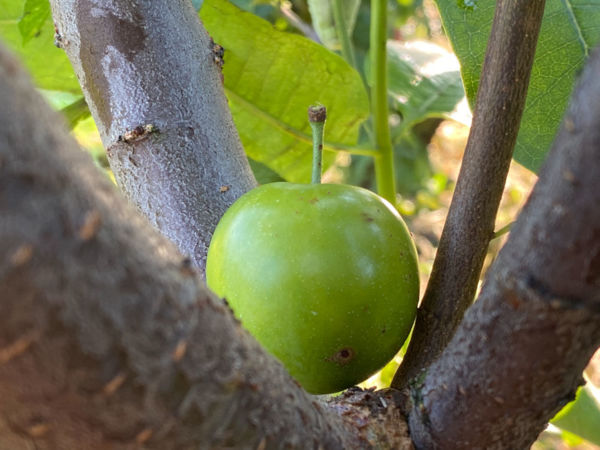An attractive, highly disease-resistant apple, ideal for organic growers.
Green Gage Plum on Myrobalan (Spring 2024)
An ancient plum for connoisseurs. Also known as Reine Claude.
The tree is smallish, with a rounded crown and low branches. It makes an attractive landscape feature with its deep green foliage and white blossom. Like many of the best heirloom fruits, Green Gage is tricky to grow and is considered very susceptible to brown rot. It should be well pruned to keep the tree open and annual, and fruit clusters will need multiple pickings. This tree is partially self-fertile, but both flavor and productivity will be improved by a pollenizer. Specific suggestions include Oullins Gage, Stanley, and Rosy Gage, but any other European plum will probably do the job.
This is an early, green-yellow, medium-sized plum with firm yet tender amber flesh. Its flavor is considered outstanding by connoisseurs. Hedrick writes in Plums of New York: "For qualities that gratify or assist in gratifying the sense of taste–richness of flavor, consistency, and texture of flesh, abundance of juice and pleasant aroma–the Reine Claude is unsurpassed."
The earliest history of the Green Gage or Reine Claude plums is obscure. It is possible that they originated in Armenia and came to Italy via Greece. They would then be identified with the fragrant plums mentioned in Pliny's Natural History. We do, however, know that this plum was introduced in France during the reign of Francis I (1494-1597) and that he named it Reine Claude in honor of his wife. The plum then acquired the name Green Gage when it was brought to England by the Gage family, and from there they came to America in the late 1700s. Green Gage has, at all times in its history been esteemed for its honeyed flavor and tender flesh.
The Fruit
Fruit Type
Category: Plum
Subcategory:
European
Fruit Uses & Storage
Uses: fresh eating, jam, baking, canning, freezing, jelly
Storage duration: less than one month (approximate, depending on storage conditions)
Fruit Appearance
Skin color: green
Flesh color: yellow
Fruit Origins
Parentage: unknown
Origin: possibly Armenia
Introduced in:
Introduced by:
The Environment
Calendar & Geography
USDA zones: 5 - 8
Chill hours: 700
Ripening date: Jul 18 (approximate, in New York State) 45 days before Stanley
Tree Height & Spacing
glossary
Rootstock: Myrobalan Rootstock
Rootstock size class: Standard (100% Size)
Tree spacing: See details
Good for wildlife planting? N
Diseases & Pests
glossary
Brown Rot, Blossom Blight, Fruit Rot: Very Susceptible
Pollination
Pollination Factors
glossary
Bloom group:
Is it self-fertile? Partial
Is it fertile? Y
Ploidy: Diploid
Rootstock size class:
Standard (100% Size)
Pollination Partners
This table shows the first few results from a full search for pollenizers of Green Gage Plum on Myrobalan. Please see our Pollenizer Search to run other queries and read how the application uses various factors. Also read more about fruit tree pollination.
See all pollination matches for Green Gage Plum on Myrobalan
Featured Products
A few things we're loving right now...
A full-flavored, freestone white peach.
One of America's oldest apples, good for storage, baking, and cider.
A widely-grown, large, yellow-fleshed nectarine.
























